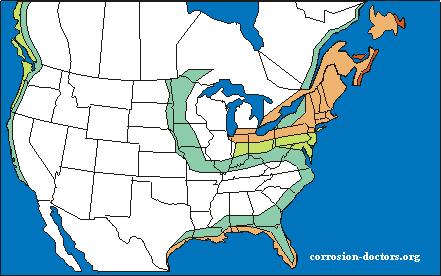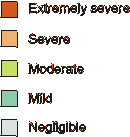
 |
The corrosion severity in various regions of America can vary greatly depending on a multitude of factors. While accelerated laboratory testing can be satisfactory for evaluating the corrosion resistance of new materials and coatings, the automobile proving grounds are definitively the primary means for testing completed systems. Proving grounds are, in effect, large laboratories. But the proving ground test contents and procedures can differ sharply between manufacturers. Because each test is expressly different, each brings different results, and in this type of test, proper interpretation of the test results is the key to successful testing.
For many years, bare steel coupons were attached to different vehicles in the northeastern U.S. and Canada. Periodically removed and measured for metal loss, the data from these coupons was used to target the corrosion test objectives to metal loss and to determine the most severe corrosion localities for captive fleet testing and future survey evaluations. The following map is a composite picture of the corrosivity differences observed in that study. (reference)


Trends in environmental quality in North America are mixed. On the positive side are improvements in some aspects of air and water quality, and reduced levels of soil erosion in much of the region. On the negative side are sharp declines in fish stocks in major marine fisheries, continued logging pressures on old-growth forests, growing invasions of exotic species and other threats to biodiversity, and increasing outbreaks of toxic organisms in estuaries and coastal zones associated with excess run-off of nutrients.
Success in reducing emissions of some toxic industrial materials must be compared with continued high levels of industrial use of such materials and slow progress in cleaning up toxic waste sites. Success in phasing out production of CFCs and other ozone-depleting gases must be balanced against failure to reduce emissions of carbon dioxide, the primary greenhouse gas, and hence the region's growing contribution to the risk of climate change. Beyond these specific issues, and underlying all of them, is the scale of economic activity in North America.
The large and robust North American economy brings many benefits, stimulating job creation, and increasing welfare and opportunities for the region's inhabitants. But it also puts increasing stresses on regional environmental quality and has major impacts across the global environment. The United States and Canada have among the highest per capita consumption of energy and other natural resources in the world, and they contribute a disproportionate share of global emissions of greenhouse gases. North American consumption also provides strong incentives for increasing international trade, leading to increased industrialization and resource use throughout the world. Thus the footprint of North America's impact on the environment stretches well beyond the region itself.
Other regions and countries: Argentina, Brazil, Canada, Central America, Chile, China, Colombia, Cuba, France, Germany, India, Italy, Japan, Mexico, New Zealand, North America, Portugal, Russia, Saudi Arabia, South Africa, Spain, Sweden, UK, USA, Venezuela
 |